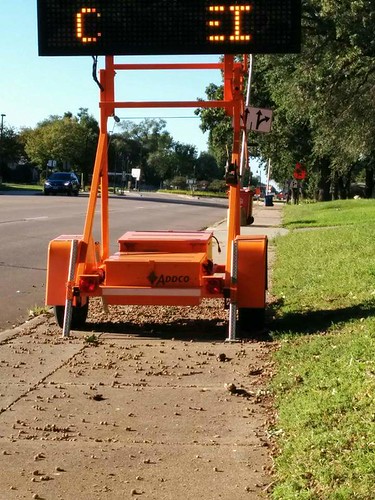Road construction season in Minnesota is winding down and, as a result, many of the orange signs that are seasonal visitors to our urban landscape will soon be warehoused away. If you’re a slab of concrete in Minneapolis with the purpose of providing space for people to walk, this may give you some breathing room.
Temporary construction signs are often placed on sidewalks or in bicycle lanes, usually without reason. I’m not sure if this is a new trend, or just something I’ve noticed more this summer. A friend snapped this shot of a temporary sign placed on Lyndale Avenue in Richfield, but I’ve noticed similar situations in many places in Minneapolis this summer as well: Chicago Ave in my neighborhood during a chip seal project, East 31st Street in Corcoran during repaving, and 5th Ave South for signs related to East 28th Street repaving.
A lane-eating corollary
I’ve noticed impacts to bicycle lanes and sidewalks from land development projects as well as street projects. Oftentimes it won’t be signs in the way of a bicycle lane or sidewalk, but rather the temporary elimination of this space in places where construction is happening adjacent to a street. I’ve noticed this on numerous blocks where my infrequent bicycle commutes to meetings downtown takes me along construction projects that extend past the curb.
While it’s understandable that building a skyscraper on a landlocked downtown parcel may require space for construction equipment and staging, we can still do a better job of providing temporary accommodations to walkers and bicyclists. It’s great many projects include complete reconstruction of the sidewalk, curb, and amenity space, but we can get to the finished state without limiting access in the short-term. Bicycle lanes, as well as sidewalks, need to be prioritized first for temporary accommodation around construction sites and through road construction projects.
Construction firms wishing to take some of this public right of way for their project need an obstruction permit. According to the city website, “There is no charge for the actual permit, but the permit is required to park vehicles in the obstructed area. Lane use fees may apply if a travel or parking lane is closed.” This makes it sound like we do charge for temporarily taking parking or “travel lanes” but we do not charge for usage of sidewalk space (and it’s unclear if bicycle lanes would be counted as “travel lanes”).
This creates an unfortunate incentive, especially on multi-lane one-way streets like what we have through much of downtown. The incentive is first to protect all space for vehicles, even parking, before accommodations are made for sidewalk users. Note: If I am interpreting this incorrectly, I hope someone from City of Minneapolis / Public Works comments to correct me.
A new approach is needed
From what I’ve seen this summer, road construction signs are placed on sidewalks despite being next to multiple travel lanes or a parking lane. That’s flat out unacceptable. It’s saying that those who cannot or chose not to drive should have a complete loss in level of service in order to avoid inconveniencing those driving cars. I propose these principles:
- First, where multiple lanes of travel in one direction remain, including parking lanes, there’s no reason to obstruct sidewalks with temporary construction signs.
- Second, there’s no reason to sacrifice bicycle lanes or sidewalks for encroachment during private construction projects so long as at least one “traffic lane” in each direction is provided.
Have you seen examples of either of these two sidewalk impacts happening this construction season? Let us know in the comments.



